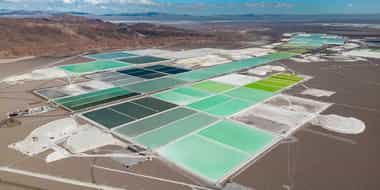
Dec 21, 2015
Blog Energy and Resources One Answer to Renewable Energy is Blowing in the Wind: Wind Turbines
In the wake of the COP21 climate summit in Paris, which yielded an historic agreement earlier this month, clear signs have emerged that an energy transition is underway: renewables contributed almost half of the world's new power generation capacity in 2014 and have already become the second-largest source of electricity (after coal), says a leading global energy organization.
According to the International Energy Agency (IEA), the coverage of mandatory energy efficiency regulation has expanded to more than one-quarter of global energy consumption. “Renewables are set to become the leading source of new energy supply from now to 2040,” notes the agency, citing its World Energy Outlook 2015 report (WEO-2015), published last month.
The IEA was founded in 1974 to help countries coordinate a collective response to major disruptions in the supply of oil works and to ensure reliable, affordable and clean energy for its 29 member countries.
“The biggest story is in the case of renewables,” IEA executive director Fatih Birol told the Guardian. “It is no longer a niche. Renewable energy has become a mainstream fuel, as of now.”
WIND ENERGY AS A RENEWABLE RESOURCE
Alternative energy sources, also called renewable resources, deliver power with minimal impact on the environment. According to BCC Research analyst Srinivasa Rajaram, these sources are typically more “green/clean” than traditional methods such as oil or coal. In addition, alternative resources are inexhaustible. For example, one renewable resource with great potential is wind energy, he says.
"Wind energy is capital intensive, but has no fuel costs," says Rajaram. "The price of wind power is therefore much more stable than the volatile prices of fossil fuel sources. There are now longer and lighter wind turbine blades, improvements in turbine performance and increased power generation efficiency."
As wind project capital and maintenance costs continue to decline, the environmental impact of wind power when compared to the environmental impacts of fossil fuels is relatively minor, he notes. “Compared with other low carbon power sources, wind turbines have some of the lowest global warming potential per unit of electrical energy generated.”
USE OF RENEWABLE GROWING GLOBALLY
The deployment of renewables continues to expand worldwide, with a strong concentration in the power sector where renewables overtake coal as the largest source of electricity generation by the early-2030s, the agency wrote in its report. Renewables-based generation reaches 50% in the EU by 2040, around 30% in China and Japan, and above 25% in the United States and India.
The big jump in renewables outlined in WEO-2015 should produce a dramatic slowdown in the growth of carbon emissions, says the agency. As reported by the Guardian, the IEA calculated the world was maintaining course for 2.7C of global warming, significantly above the 2C considered as the threshold of dangerous warming. “A major course correction is still required,” says the IEA’s report.
The increasing use of wind energy will be a key component of any corrective effort, Rajaram notes.
“Wind energy usage has been growing and expanding to new regions worldwide. Globally, total investments in small wind, onshore wind and offshore wind energy in various regions reached about $130 billion at the end of 2013 and these investments are expected to reach $250 billion in 2020,” he explains. “These investments include the basic cost of all types of wind turbines put together; balance of costs involved in transportation, foundation, assembly and erection of these turbines; and soft costs involved in insurance, contingency and other miscellaneous costs.”
With largely untapped wind energy resources around the globe and declining wind energy costs, the world is now moving forward into the 21st century with an aggressive initiative to accelerate the progress of wind technology, and further reduce its costs, to create new jobs and to improve environmental quality. The winds of change are in the air, it seems.

In an era marked by environmental consciousness and the pursuit of sustainable e...

Lithium, often referred to as "white gold," is a vital component in rechargeable...

In today, the biofuels market has been evolving as a part of the broader renewab...

We are your trusted research partner, providing actionable insights and custom consulting across life sciences, advanced materials, and technology. Allow BCC Research to nurture your smartest business decisions today, tomorrow, and beyond.
Contact UsBCC Research provides objective, unbiased measurement and assessment of market opportunities with detailed market research reports. Our experienced industry analysts assess growth opportunities, market sizing, technologies, applications, supply chains and companies with the singular goal of helping you make informed business decisions, free of noise and hype.